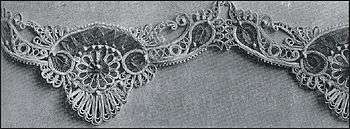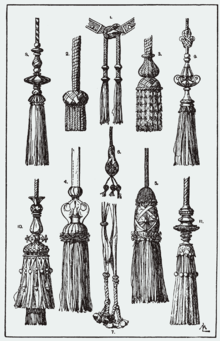Passementerie
Passementerie (/pæsˈmɛntri/, French pronunciation: [pɑsmɑ̃tri]) or passementarie is the art of making elaborate trimmings or edgings (in French, passements) of applied braid, gold or silver cord, embroidery, colored silk, or beads for clothing or furnishings.[1]

Styles of passementerie include the tassel, fringes (applied, as opposed to integral), ornamental cords, galloons, pompons, rosettes, and gimps as other forms. Tassels, pompons, and rosettes are point ornaments, and the others are linear ornaments.
Overview
Passementerie worked in white linen thread is the origin of bobbin lace,[2] and passement is an early French word for lace.[3]
Today, passementerie is used with clothing, such as the gold braid on military dress uniforms, and for decorating couture clothing and wedding gowns. They are also used in furniture trimming, such as the Centripetal Spring Armchair of 1849 and some lampshades, draperies, fringes and tassels.
History

In the West, tassels were originally a series of windings of thread or string around a suspending string until the desired curvature was attained. Decades later, turned wooden moulds, which were either covered in simple wrappings or much more elaborate coverings called "satinings", were used. This involved an intricate binding of bands of filament silk vertically around the mould by means of an internal "lacing" in the bore of the mould. A tassel is primarily an ornament, and was at first the casual termination of a cord to prevent unraveling with a knot. As time went on, various peoples developed variations on this.
In the 16th century, the Guild of Passementiers was created in France. In France practitioners of the art were called "passementiers", and an apprenticeship of seven years was required to become a master in one of the subdivisions of the guild.
The Guild documented the art of passementerie. The tassel was its primary expression, but it also included fringes (applied, as opposed to integral), ornamental cords, galloons, pompons, rosettes, and gimps as other forms. Tassels, pompons, and rosettes are point ornaments; the others are linear ornaments. These constructions were varied and augmented with extensive ornamentations. These constructions were each assigned an idiosyncratic term by their French practitioners.
The French widely exported their very artistic work, and at such low prices that no other nation developed a mature "trimmings" industry. Tassels and their associated forms changed style throughout the years, from the small and casual of Renaissance designs, through the medium sizes and more staid designs of the Empire period, and to the Victorian Era with the largest and most elaborate.
In Scotland at the end of the 16th century some passementerie was made with inferior gold and silver thread which quickly tarnished. On 6 May 1593 the Duke of Lennox and his friends decided not to wear any passementerie for a year, especially "passements great or small, plain or 'a jour', bissets, lilykins, cordons, and fringes".[4]
Passementerie with clothing was for a long time reserved for the elites as a sign of social distinction among royalty, aristocracy, religious, and military. Since the 18th century, the use became largely obsolete with the simplification of clothing.
Periodically historic designs return to favour by Interior and Fashion Designers. The middle of the 20th century saw a marked decline in the production and range of these products. The latter part of the 20th century has seen a resurgence in interest partly led by the film industry's set designers and costumiers. European and American artisans specialising in hand-made products are increasing in number.
References
- The art of passementerie Archived 2012-01-12 at the Wayback Machine
- Montupet, Janine, and Ghislaine Schoeller: Lace: The Elegant Web, ISBN 0-8109-3553-8
- S.F.A. Caulfeild and B.C. Saward, The Dictionary of Needlework, 1885.
- Historical Manuscripts Commission, Appendix 4th Report: Mrs. Erskine Murray (London, 1874), p. 527.
Further reading
- Picken, Mary Brooks, The Fashion Dictionary, Funk and Wagnalls, 1957. (1973 edition ISBN 0-308-10052-2, 1999 Dover republication ISBN 0-486-40294-0)
- Annabel Westman, Fringe Frog & Tassel: The Art of the Trimmings-Maker in Interior Decoration in Britain and Ireland, Philip Wilson, London, 2019. ISBN 978-1-78130-075-6
External links
- Passementerie page at "The Tailor's Art," Museum of the Fashion Institute of Technology.
